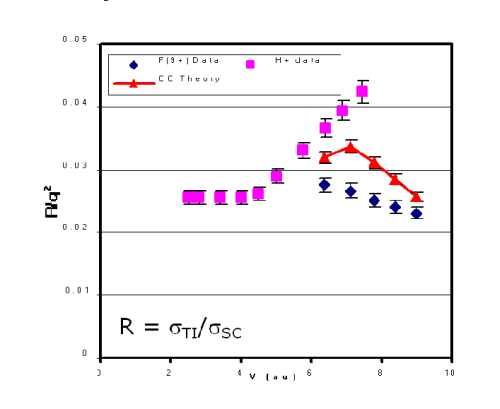CHARGE AND VELOCITY DEPENDENCES OF TRANSFER IONIZATION TO
SINGLE CAPTURE RATIO FOR FAST MULTIPLY CHARGED IONS ON HE
R. Ünal, P. Richard, I. Ben-Itzhak , C. L. Cocke , M. J. Singh*,
H. Tawara, N. Woody , C. D. Lin and H. C. Tseng
J.R. Macdonald Laboratory, Kansas State University, Manhattan, Kansas 66506
In this paper, we report on the velocity and projectile charge dependences of the
ratio of Transfer Ionization, TI, to Single Capture, SC, for high velocity multiply
charged ions on He.
Measurements were performed in the J. R. Macdonald Laboratory at Kansas State
University. Ion beams of interest were extracted from the EN tandem Van de Graaff
accelerator, post-stripped when necessary, momentum analyzed, and the desired charge
state directed to the collision area. The target was provided using a supersonic
He jet with a two-stage collimation1.
The q-dependence of the ratio, R, of TI to SC for 2 MeV/u projectiles is presented
in Fig. 1. The present results indicated by triangles are for F and Si beams. The
solid curve indicates the q2 dependence of R. Anti-screening leads to cross sections
greater than the values predicted by the q2 dependence.
Fig. 2 shows the velocity dependence of R for Fq+ on He in the range of
v=6 to 9 au.
The cross section is scaled by 1/q2 and compared to the H+
on He results of Mergel et al.3
R for the two cases show a stark contrast. Coupled channel calculations for F9+ on
He follow the trend of the present data4.
Figures:

Figure 1:
The ratio of the TI to SC cross sections for dressed and bare projectile
ions incident on He is shown.
The data included in the paper by Montenegro et al.2,
are given together with the present results (triangles).

Figure 2:
A scaled ratio of transfer ionization to single capture for bare projectiles
incident on He.
Included are the data of the present work, data of Mergel et al.3
and a coupled channel calculation for F9+ on He.
References:
1) R. Unal et al., accepted CAARI 2000, Denton, TX.
2) E. C. Montenegro et al., Phys. Rev. A, 55, 2009 (1997).
3) V. Mergel, Ph. D Thesis, University of Frankfurt, 1996.
4) R. Unal et al., to be published.
*Present address: Institute for Plasma Research, Bhat, Gandhinagar 382428 India
This work was supported by the
Chemical Sciences, Geosciences and Biosciences Division,
Office of Basic Energy Sciences,
Office of Science,
U.S. Department of Energy.
Submitted to ICPEAC 2001, July 2001 in Santa Fe, NM.
This abstract is also available in
Postscript or
Adobe Acrobat formats.

